日本桥梁抗震课件
- 格式:pdf
- 大小:583.95 KB
- 文档页数:71

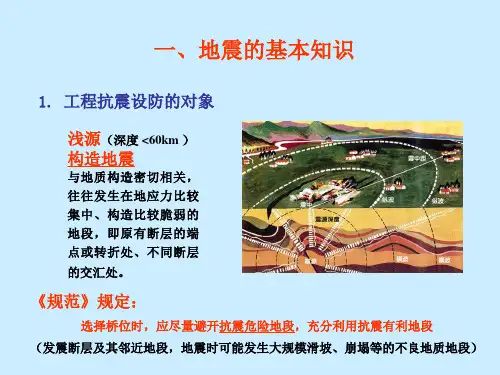
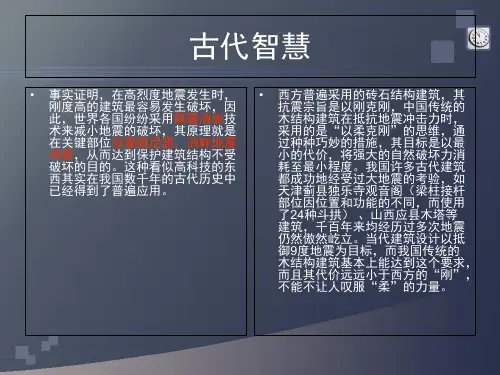
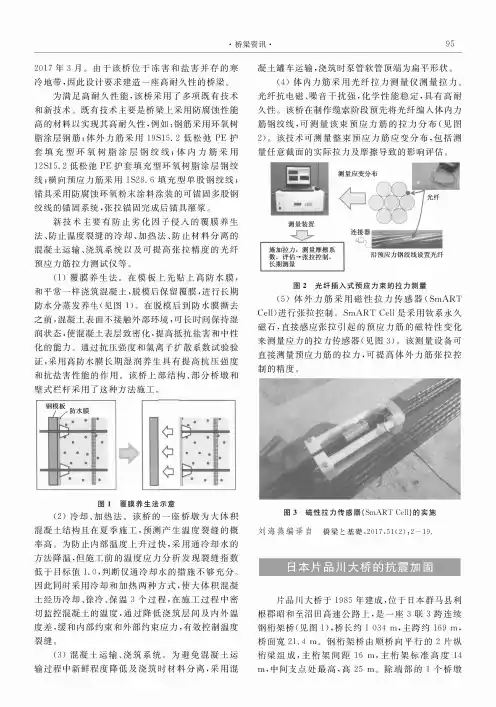



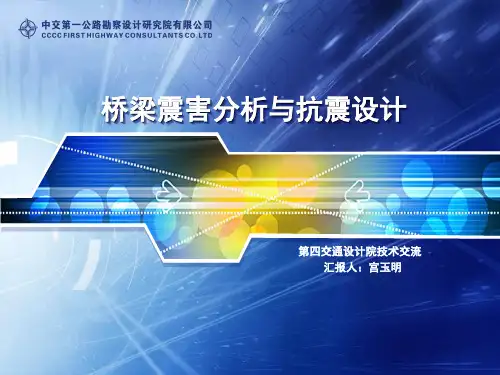
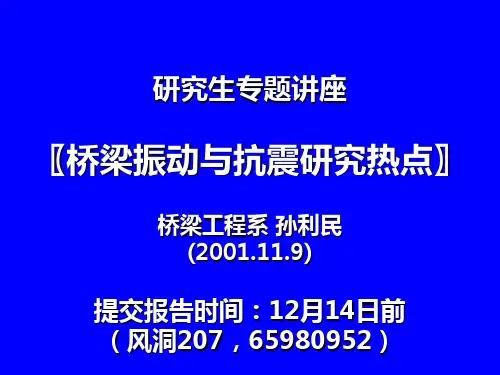

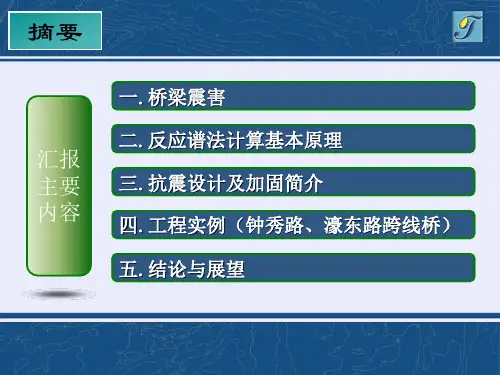
目录V抗震设计篇第1章总则51.1适用范围51.2用语的定义5第 2 章抗震设计的基本方针72.1抗震设计的基本72.2抗震设计的原则82.3划分桥梁的重要度10第3章抗震设计时必须考虑的载荷123.1抗震设计时必须考虑的载荷和其组合123.2地震的影响12第4章设计地震运动144.1 一般144.2 1级地震运动154.3 2级地震运动174.4 按地域区分的修正系数204.5抗震设计上的地基种类254.6 抗震设计上的地基面26第5章抗震性能的检查295.1 一般295.2对于抗震性能1的桥梁的界限状态315.3对于抗震性能2的桥梁的界限状态315.4对于抗震性能3的桥梁的界限状态365.5抗震性能的检查方法385.6防止上部构造掉落的对策41第6章抗震性能的静态检查方法426.1 一般426.2适用静态检查法的情况的载荷计算方法436.2.1 一般436.2.2惯性力436.2.3固有周期的估计方法486.2.4 地震时的土压566.2.5地震时的动水压力606.3检查1级地震动的抗震性能646.3.1 一般646.3.2惯性力的计算方法656.3.3设计水平地震烈度726.3.4 抗震性能1的检查746.4检查2级地震动的抗震性能766.4.1 一般766.4.2惯性力的估算方法776.4.3设计水平地震烈度776.4.4构造物特性修正系数816.4.5抗震性能2或抗震性能3的检查846.4.6钢筋混凝土桥墩的检查856.4.8桥台基础的检查906.4.9 上部构造的检查916.4.10支承部的检查91第7章抗震性能的动态检查方法927.1 一般927.2用于动态解析的地震动937.3解析模型以及解析方法947.3.1解析模型以及解析方法947.3.2部件的模型化967.4检查抗震性能98第8章地震时不稳定的地基的影响1018.1 一般1018.2被判断为抗震设计上的极松软土层或产生对桥梁造成影响的液状化的砂质土层的土质常数1028.2.1 一般1028.2.2判断抗震设计上的极松软土层1028.2.3判断砂质土层的液状化1028.2.4使抗震设计上土质常数减小的土层及其处理方法1058.3有确认会造成对桥梁产生影响的流动化的地基存在时的抗震性能的检查1078.3.1 一般1078.3.2流动力的估算方法109第9章抗震桥的抗震性能检查1129.1 一般1129.2抗震桥的抗震性能检查1159.3抗震支承的模型化1179.3.1 一般1179.3.2抗震支承的非线性历史模式1179.3.3抗震支承的等价线形模型1189.4抗震支承的基本性能1219.5期待可以减小地震的影响的其他构造122第10章钢筋混凝土桥墩的地震时保有水平耐力及容许塑性率12310.1 一般12310.2破坏形态的判断和地震时保有水平耐力及容许塑性率12410.3水平耐力及水平变位的计算12710.4混凝土的应力度一变形曲线13210.5抗剪耐力13610.6为了提高钢筋混凝土桥墩的韧性而需要注意的构造细目13910.7轴向钢筋之分段14610.8钢筋混凝土Rahmen桥桥墩的地震时保有水平耐力及容许塑性率 (147)10.9上部构造等的死载荷导致的偏心力矩起作用的钢筋混凝土桥墩156第11章钢制桥墩的反应值和容许值16011.1 一般16011.2通过动态检查法进行检查16111.3构造细目16711.4锚栓部位的检查171第12章桥墩基础的反应值和容许值17312.1 一般17312.2计算桥墩基础上产生的断面应力、地基反力及变位17612.3基础的屈服17912.4计算考虑桥墩基础的塑性化时的桥墩基础反应值18012.5桥墩基础的容许塑性率及容许变位18212.6桥墩基础的部件的检查183第13章位于产生液化状的地基的桥台基础的反应值和容许值18413.1 一般18413.2用于桥台基础检查的设计水平地震烈度18513.3计算桥台基础的反应塑性率18713.4桥台基础的容许塑性率18813.5桥台基础的部件的检查188第14章受到地震影响的上部构造的容许值和上部构造端部构造18914.1 一般18914.2钢上部构造19014.2.1 耐力和容许变形量19014.2.2构造细目19014.3混凝土上部构造19114.3.1耐力和容许变形量19114.3.2构造细目19314.4上部构造端部构造19414.4.1上部构造端部的游间19414.4.2伸缩装置19714.4.3 伸缩装置保护罩198第15章支承部的检查20015.1 一般20015.2用于支承部检查的设计地震力20215.3支承部检查20515.4支承部位的构造20815.5变位限制构造209第16章落桥防止系统21216.1 一般21216.2横梁结合长度21516.3落桥防止构造22316.4高度差别防止构造22616.5变位限制构造226第1章总则1.1适用范围本文章适用于桥梁的抗震设计。
第1章总则1.1 适用范围明确抗震设计篇的适用范围。
适用的桥梁和操作与共通篇1.1适用的范围相同。
1.2 用语的定义第2章抗震设计的基本方针2.1 抗震设计的基本(1)桥梁在地震后作为避难道路及通往救助、急救、医疗、消防活动及向受灾区输送紧急物资的运输道路等担任了非常重要的作用。
因此,在桥梁的抗震设计上,必须有确保地震时的桥梁安全观念的同时,按照桥梁的重要度,尽可能控制因桥梁的功能下降而导致的对地区社会生活造成的障碍。
根据桥梁作用的重要性,在桥梁的抗震设计中的基本在于根据设计地震运动的震级和桥梁的重要性来确保桥梁必要的抗震性能。
(2)通过考虑地形、地质、地基条件、布局条件等后,选择具有适当地抗震性的桥梁构造形式是很重要的。
另外,必须以在增强构造部件强度的同时提高变形性能,以建造桥梁整体可以抵抗地震构造系统为目标。
据此观点,将抗震设计上较好的构造形式与抗震设计上欠妥的构造形式记述如下。
1)为确实防止上部构造的掉落,最好选择尽可能大的跨度连续构造的桥梁构造形式。
大跨度连续构造的支承条件有单点固定方式和地震时水平力分散构造等,通常在单点固定方式的大跨度连续构造中,因为支撑固定支承的下部构造的负担容易变得过大,所以这时最好选择地震时水平力分散构造。
另外,若有山丘部的高桥墩的桥梁等、桥台部的地基条件良好时,因位从此时的构造来看,由桥墩负担地震时水平力比使用桥台负担更为合理,所以为了提高桥梁整体的抗震性,最好根据桥梁的构造条件和基础地基的支撑条件等恰当地选择支承条件。
2)在可能产生软质粘性土层的滑动性和沙质地基的液状化、及其伴随液状化的流动化等地基变化的填埋地基和冲积地基上,选择水平刚性较高的基础、和多点固定方式和Rahmen桥形式等,上部构造和下部构造的接点尽可能多的构造体系。
3)地基条件良好、固有周期短的大跨度连续形式的桥梁最好采用抗震设计。
4)在可能因部分的损坏导致整个体系崩溃的构造系统中,必须考虑如何限定该部分的损坏。
Chapter 6 Seismic Design of BridgesKazuhiko Kawashima Tokyo Institute of TechnologySeismic Designz Loading environment (dead, live, wind, earthquake etc)z Performance criteria for gravity (deflection, stresses) and environmental loads (damage, displacement, collapse)z Geometric (space) requirementsz Time available for constructionz Soil conditionz Costz..Seismic Design Process with Emphasis on Japanese Seismic DesignJapanese Codes for Design of Highway BridgesJapan Road Associationz Design Specifications of Highway Bridges9Part I Common Part9Part II Steel Bridges9Part III Concrete Bridges9Part IV Foundations9Part V Seismic Designz The code applies to highway bridges with acenter span no longer than 200m919809199091996920021971Code and the Latest Code (2002)20021971Part V Seismic Design, Design Specifications of Highway Bridges, Japan Road Association1. General2. Principles of seismic design3. Loads considered in seismic design4. Design ground motions5. Evaluation of seismic performance6. Performance evaluation by static analysis7. Performance evaluation by dynamic analysis8. Effect of unstable soils9. Menshin design (Seismic Isolation)Part V Seismic Design, Design Specifications of Highway Bridges, Japan Road Association (continued)10. Strength & Ductility of RC piers11. Demand & capacity of steel piers12. Demand & capacity of foundations13. Demand & capacity of abutment foundations on liquefiable ground14. Demand & capacity of superstructures15. Seismic design of bearings16. Unseating prevention devicesSeismic Performance GoalsSeismic Performance CriteriaJames Roberts (1999), Previous Caltran’s Chief Engineer z How do you want the structure to perform in an earthquake?z How much danger can you accept?z What are the reasonable alternate routes?Seismic Design ForceSeismic Design Forcez Seismic design force should be determined based on the seismic environment (seismicity, fault length and rupture, etc) around the construction sitesz Seismic hazard map in terms of PGA is frequently used to scale the seismic design force.z Response accelerations are widely used to provide the seismic design force of bridges. Multiplying it to mass, lateral force can be directly evaluated.z Standard response spectra are generally modified to take account of regional seismicity asz Importance of structures are sometimes reflected to evaluate the design seismic force. There are two groups in this treatment as9Larger design seismic force is considered for a structure with higher importance9Since seismic force which applies to a structure does not change depending on the importance of the structure, the importance is considered in the evaluation of the capacitySeismic Design Force (continued)dards A z design A T S c T S tan ),(),(ξξ⋅=JapanCaltransType IType IIM=7.25 0.25M=8.0 0.25++New ZealandEC8AASHTOComparison of Design Response Accelerations (continued)00.511.522.50123Period (sec)Soft Soil Sites00.511.522.50123S e i s m i c C o e f f i c i e n tPeriod (sec)Stiff Soil SitesDeterministic or Probabilistic?z Deterministic ground motions which occurred in Tokyo during the 1923 Kanto EQ and in Kobe during the 1995 Kobe EQ is used with modification of regionalM7.2, 2008. 6.14 M7.3, 2000.10.6Max. magnitude which could happen due to hidden faults inside Japanzzzz ECzz9M J7.29 M J8Seismic Zoning Map widely accepted in Japan since 1983z 12 100z53 3This minimum value was very important tomitigate damage 0.7 0.8Evaluation of DemandWhere do we consider the damping characteristics of the bridge in the static design?Safety Evaluation Ground MotionType II GM⎪⎩⎪⎨⎧≤≤≤≤<⋅=TT T S T T T S T T T S c S s s s Z esSII 63/4965853/27 / 0 ⎪⎩⎪⎨⎧<≤<≤<⋅⋅⋅=)( /)( )0( 63/5965853/27T T T S T T T S T T T S c c S D Z SII Japanese practice to take the damping ratio of bridge into account in the static design forceDynamic response analysis )05.0,(T S A Static analysis )/02.0,(T T S AJapanese practice to take the damping ratio of bridge into account in the static design force0.511.522.501234R e s p o n s e A c c l e r a t i o n (g )Natural Period (s)Ground IGround II Ground III Ground IGround II Ground IIIType I Type II SDynamic response analysis)05.0,(T S A 00.511.522.501234Natural Period (s)R e s p o n s e A c c l e r a t i o n (g )S SGround IGround II Ground III Ground IGround II Ground IIIType I Type II (b)RA l i f E i lStatic analysis)/02.0,(T T S A。